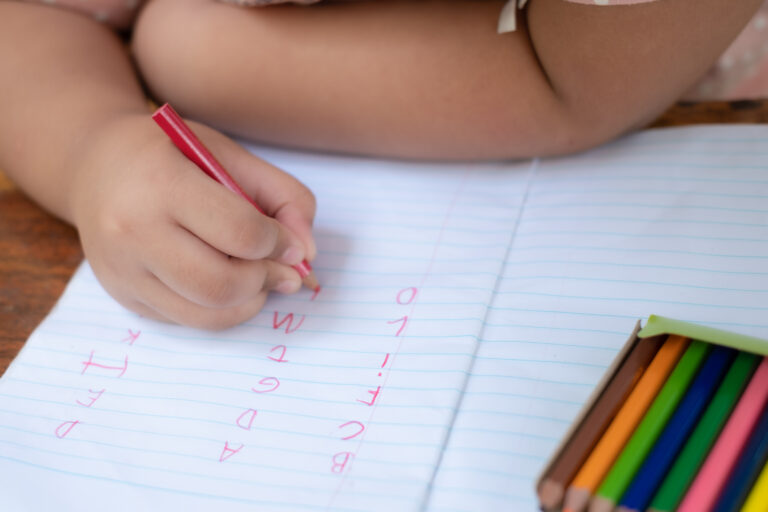During my work with children in childcare centres, I’ve witnessed the miraculous journey from their first scribbles to the proud moment they write their names.
This path is not just about learning letters and numbers; it’s deeply intertwined with developing fine motor skills, the foundation for early writing success.
Let me share with you the insights and strategies I’ve gathered and tested over the years, ones that have been my secret weapons in supporting children as they make this fascinating transition.
Understanding the Link Between Fine Motor Skills and Writing
Before children can master the art of writing, they need to develop the fine motor skills that enable them to hold a pencil, control their movements, and express their thoughts on paper.
The Role of Fine Motor Development
Fine motor skills involve the coordination of small muscles in movements—usually involving the synchronization of hands and fingers—with the eyes.
In my experience, nurturing these skills early on is crucial for children’s writing readiness.
From picking up small objects to manipulating playdough, each activity builds the strength and dexterity they’ll need for writing.
Recognizing Milestones in Fine Motor Development
In my work, I’ve seen a wide range of developmental milestones related to fine motor skills.
These include grasping and releasing toys, building with blocks, and eventually, holding a pencil correctly.
Recognizing and celebrating each of these milestones reinforces children’s progress and boosts their confidence.
Strategies to Support Fine Motor Development
Over the years, I’ve tried, tested, and refined numerous activities designed to strengthen fine motor skills. Here are some that have proven to be particularly effective.
Engaging in Play-Based Learning
Play-based learning has been my go-to approach. Incorporating play activities that promote fine motor skills—like threading beads, using tongs to transfer items, or playing with puzzles—has not only been incredibly effective but also immensely enjoyable for the children.
Creating Art and Craft Projects
Art and craft projects offer a fun and creative way to develop fine motor skills.
Whether it’s cutting with safety scissors, gluing pieces to create a collage, or using a paintbrush, these activities have been instrumental in improving children’s hand-eye coordination and dexterity, setting a solid foundation for writing.
Incorporating Everyday Activities into Fine Motor Practice
I’ve found that opportunities to practice fine motor skills can be found in many everyday activities.
Encouraging independence in tasks like buttoning clothing, zipping up bags, and using utensils for eating can significantly enhance these skills.
Utilizing Manipulatives and Tools
Incorporating tools and manipulatives designed to build fine motor skills into daily routines and playtime has been another successful strategy.
Items like tweezers for pick-up games, dough to squeeze and mold, and lacing cards are not only fun but highly effective in strengthening the tiny muscles in children’s hands.
Involve Children in Meal Preparation
Meal preparation offers a plethora of fine motor development activities. I’ve found that involving children in safe kitchen activities, like washing fruits, stirring ingredients, or spreading peanut butter on bread, significantly enhances their fine motor skills.
These tasks not only improve grip strength and control but also introduce children to sensory experiences and the joy of creating something they can enjoy.
Practice Gardening Activities
Gardening, whether in outdoor beds or indoor pots, is a wonderful way to engage children in fine motor practice. Digging in soil, planting seeds, and watering plants require precise movements and gentle care.
I’ve personally used gardening projects to teach children about nature while simultaneously refining their grasp, release movements, and overall hand coordination.
Observing the growth of the plants they’ve tended to with their own hands has been an incredibly fulfilling experience, reinforcing the value of patience and care.
Fostering an Environment That Promotes Writing Readiness
Creating an environment that encourages exploration, experimentation, and practice is key to fostering writing readiness.
Encouraging Scribbling and Drawing
I’ve always encouraged scribbling and drawing from an early age. Providing a variety of writing tools and paper and celebrating these early “marks” as important steps in learning to write has been a way to motivate children to explore writing as a form of expression.
Introducing Letters and Numbers in Context
Introducing letters and numbers in meaningful contexts, rather than isolation, helps children understand the purpose behind writing.
Labeling items in the classroom, creating simple word cards, and incorporating letters and numbers into art projects have been methods I’ve used to integrate literacy skills naturally into their environment.
Collaborating with Families for Continued Support
Partnering with families is essential in extending support for fine motor development and writing readiness beyond the classroom.
Sharing simple activities, ideas, and the importance of these skills can empower parents to become active participants in their child’s development.
Sharing Resources and Ideas for Home Activities
I’ve made it a point to share resources and simple activity ideas with families that can be easily done at home.
From kitchen activities that involve stirring and pouring to outdoor play that encourages picking, digging, and drawing, there are endless opportunities to practice fine motor skills in everyday life.
Final Thoughts
In my years of nurturing young minds and guiding tiny hands, I’ve seen the incredible impact that focused support for fine motor development can have on a child’s ability to write.
It’s a journey filled with colorful scribbles, playful exploration, and triumphant first letters that mark the beginning of a lifelong adventure in learning and expression.
As educators and caregivers, our role is to provide the tools, encouragement, and opportunities for children to develop these essential skills, paving the way for their writing success and so much more.












